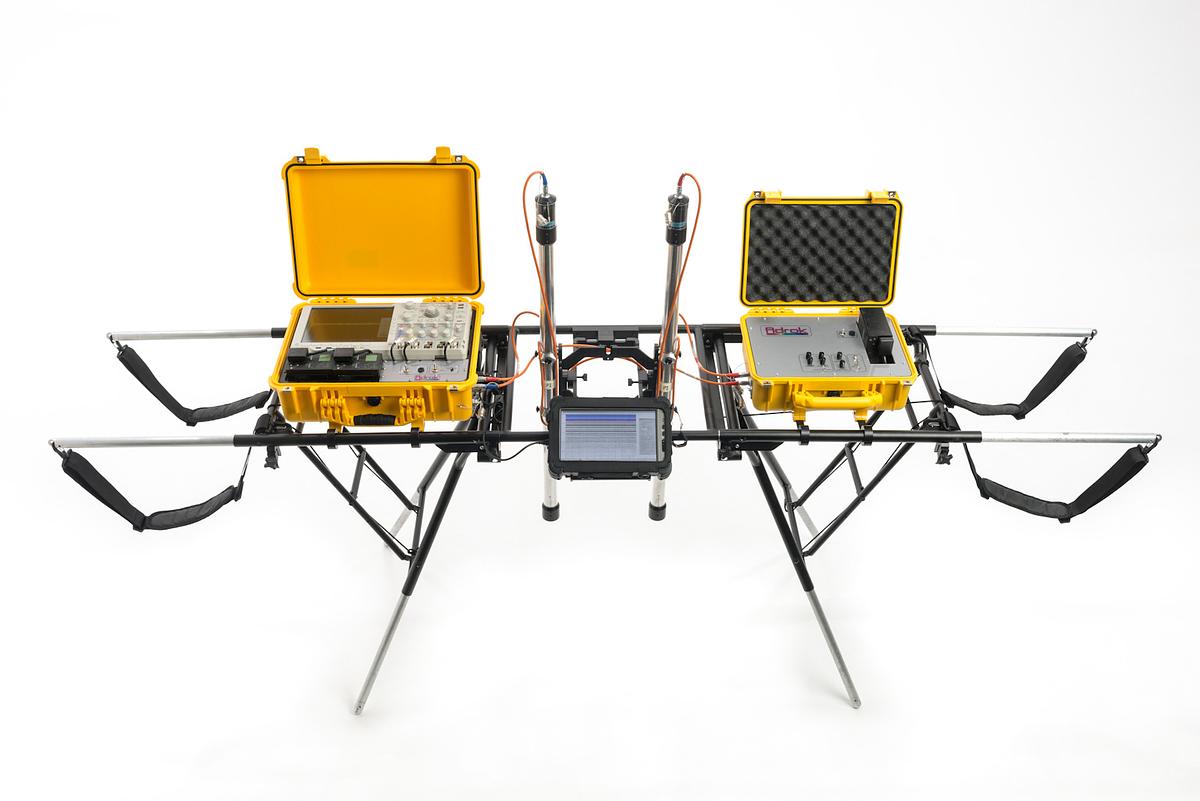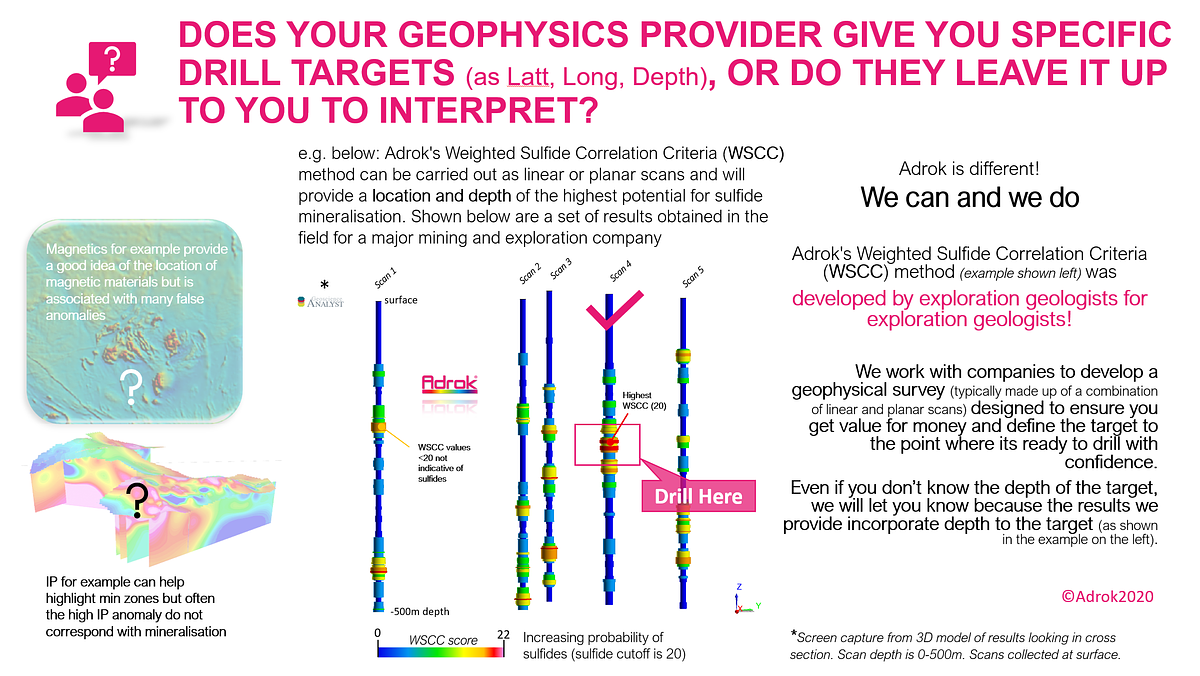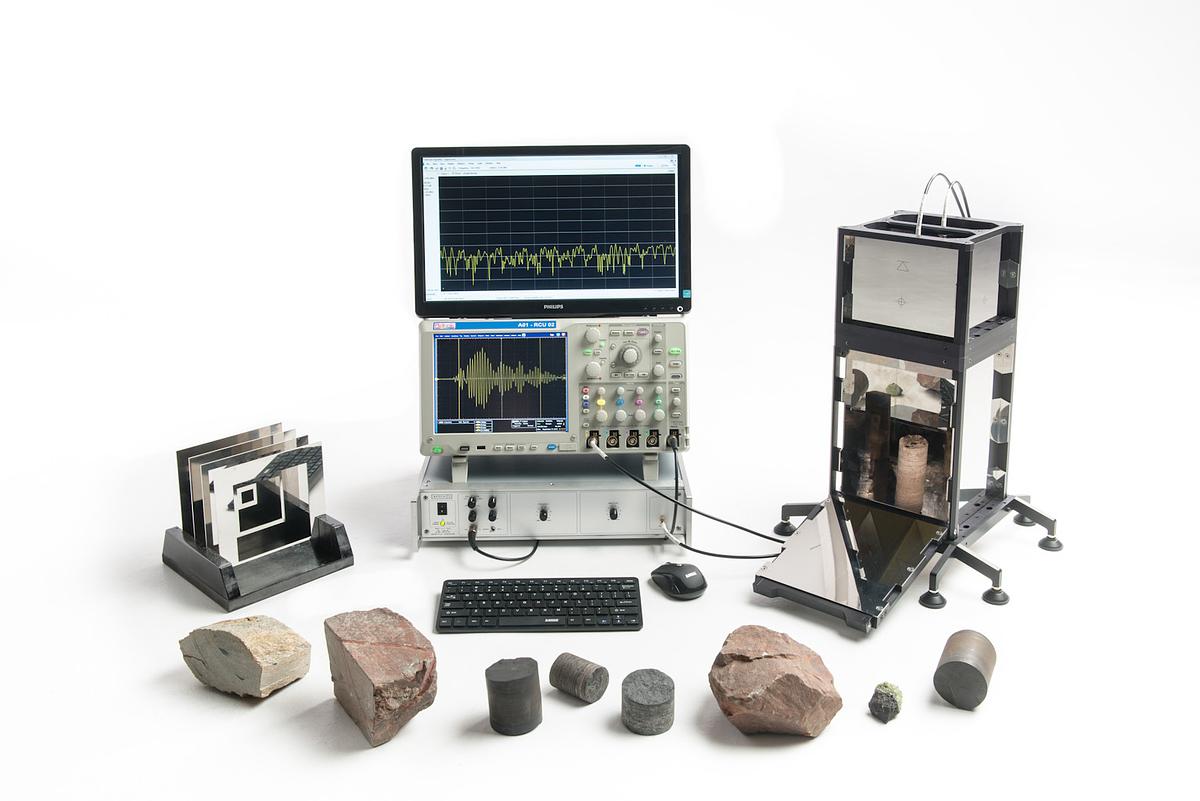Our ability to identify and map resources has been the true breakthrough
After obtaining subsurface data received by the scan, we positively identify the substances using two methods: spectroscopy (this turns our wavelength data into a decipherable spectrum), and Dielectrics - where the readings we obtain are compared with our existing table of substance classification (for example, water has a reading of 80, whereas air has a reading of 1).
In addition to classification, the readings can also analyse fluid content and physical characteristic facts - like well logs and rock petrography. Please download a copy of our capabilities here.

We can also map the length and depth of the substance to an unrivalled accuracy. Because our electromagnetic waves reflect AND absorb we can potentially measure its three dimensional shape and capacity as well as an exact position. So - no more guesswork!
High quality mapping is probably the most important advantages to the Adrok scanner. The more you know about your resource the more you can effectively extract it. Within the oil and gas and mining sectors, substances can now be quantified before extraction. Our technology can also be used to develop further new reserves as well as monitor existing producing resources.
The Adrok scanner can identify liquids - like hydrocarbons or water, and minerals - like Copper and Uranium, and the scanner is portable enough to be used in all terrains and transport – be it desert, jungle, mountain – on a boat, plane, helicopter or truck.
More recently, our research has produced a new proxy measurement for bulk density (as corroborated by drill holes). Please download a copy of our density work here.

Spectroscopy
Spectroscopy is a technique used to analyse the interaction between matter and electromagnetic radiation. It allows scientists to determine the composition, structure, and physical properties of matter by examining how it absorbs, emits, or scatters light. Electromagnetic Spectroscopy involves the use of electromagnetic radiation, which includes a wide range of wavelengths from gamma rays to radio waves. Different types of spectroscopy focus on different parts of this spectrum.
Artificial Intelligence (AI) is a tool, not the end goal in mineral exploration. It serves as a powerful enabler, helping geologists, geophysicists, and exploration companies make better, faster, and more cost-effective decisions. Machine learning algorithms identify relationships between known deposits and unexplored regions with similar characteristics. AI-driven predictive modeling improves the odds of discovering economically viable deposits.
AI minimizes environmental impact by focusing exploration efforts only where necessary. Machine learning can help find critical minerals for the energy transition (e.g., lithium, nickel, cobalt).
Adrok has been using AI (and machine learning and neural network techniques) for over 2 decades to help better identify minerals hidden under cover; training on known ore bodies, rock layers and mineral zones. We have traditionally called this process “Typecasting”.

Typecasting: Adrok’s AI-Driven Approach to Subsurface Exploration
At Adrok, we have been at the forefront of machine learning and AI-driven geoscience for over 20 years. Our proprietary AI technique, which we call Typecasting, is a game-changing approach to analyzing, classifying, and interpreting subsurface materials with unmatched accuracy.
But what exactly does Typecasting mean in the context of Adrok’s technology?
What is Typecasting?
Typecasting is Adrok’s proprietary AI and machine learning process used to identify and classify different subsurface materials based on their unique electromagnetic responses.
It works by: ✅ Recognizing patterns in geological data captured by our ADR (Atomic Dielectric Resonance) technology. ✅ Matching those patterns to known rock, mineral, and fluid types using a vast geological database. ✅ Predicting the composition and structure of unknown subsurface formations with high precision.
Essentially, Typecasting teaches ADR how to "see" below the surface in the same way an expert geologist would, but faster and with greater accuracy.
How Does Typecasting Work?
1️⃣ Data Collection 📡
- ADR technology scans the subsurface, collecting electromagnetic resonance signals from different depths and materials.
2️⃣ Pattern Recognition & AI Analysis 🤖
- Typecasting applies machine learning algorithms to recognize distinct electromagnetic signatures for different rock types, minerals, and fluids.
3️⃣ Material Classification & Prediction 🏗️
- The system compares new data to its existing training models to determine the likely composition of the subsurface.
- This allows for accurate real-time geological interpretation.
4️⃣ Continuous Learning & Improvement 📊
- As new data is collected, the Typecasting system refines its models, improving accuracy and predictive power over time.
Why is Typecasting Important?
🔹 Higher Accuracy – More precise material identification, reducing errors in exploration. 🔹 Faster Decision-Making – AI-driven interpretation speeds up the exploration process. 🔹 Cost Reduction – Fewer unnecessary drill holes and exploration inefficiencies. 🔹 Non-Invasive & Sustainable – Helps reduce the environmental impact of resource discovery.
Real-World Applications of Typecasting
🌍 Mining & Critical Minerals – Differentiating between ore bodies and waste rock. 💧 Water Exploration – Identifying freshwater reserves in arid regions. ⚡ Geothermal Energy – Locating high-potential geothermal reservoirs. 🪐 Space Exploration – Identifying subsurface water ice and minerals on other planets.
Typecasting – The Future of AI in Geosciences
Typecasting is Adrok’s AI-powered tool for revolutionizing subsurface exploration. By applying advanced machine learning to ADR data, we provide faster, more accurate, and cost-effective insights—helping industries explore resources with greater efficiency and minimal environmental impact.
Please download some of our work from non-invasively scanning rocks using one of our laboratory systems, at the famous Royal Ontario Museum in Toronto, showed sulphides can be separated from silicates using energy measurements derived from FFT at statistically significant levels.
Predrilling Virtual Logging ® .
Its Less Boring with Adrok ® .
🚀 Typecasting isn’t just AI—it’s 20+ years of machine learning expertise, built into the future of geoscience. 🌍




